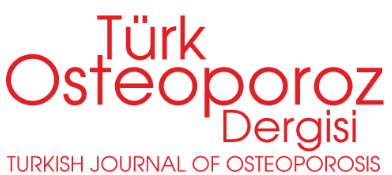Aim: N-Telopeptides (NTX), which are known as bone turnover markers are being increasingly used in early diagnosis of osteoporosis, determining the fracture risk and following up of the treatment outcome. Material and Method: In this study serum and urine NTX levels of postmenapousal patients [ages 60-83 (mean 69.45), n: 11] with no previous treatment of osteoporosis are compared with the levels after 6-months of risedronate treatment and serum and urine NTX levels of the control group [ages 57-73 (mean 64.64), n: 11]. Results: Consequently serum NTX (sNTX) levels of postmenapousal patients before risedronate therapy were significantly higher then the sNTX levels of the control group. After risedronate therapy sNTX levels were significantly higher and urine (uNTX) levels were lower when compared with the NTX levels before treatment. Also either sNTX or uNTX levels before and after the treatment were positively and strongly correlated. Discussion and Conclusion: Eventually bone turnover markers carry much importance in diagnosis and follow-up the treatment. Also the strong correlation between levels of NTX before and after the treatment shows that the sensitivity and specifity of these methods are high. Therefore they can be used as an alternative and adjunct method to bone densitometry to assess the response to treatment, especially to demonstrate the early changes. (Osteoporoz Dünyasindan 2006;12:55-9)Key words: Bone markers, Serum N-telopeptide, ürine N-telopeptide, risedronate, postmenopausal osteoporosis
Article in Turkish(Use the link for full-text in Turkish)
Aim: N-Telopeptides (NTX), which are known as bone turnover markers are being increasingly used in early diagnosis of osteoporosis, determining the fracture risk and following up of the treatment outcome. Material and Method: In this study serum and urine NTX levels of postmenapousal patients [ages 60-83 (mean 69.45), n: 11] with no previous treatment of osteoporosis are compared with the levels after 6-months of risedronate treatment and serum and urine NTX levels of the control group [ages 57-73 (mean 64.64), n: 11]. Results: Consequently serum NTX (sNTX) levels of postmenapousal patients before risedronate therapy were significantly higher then the sNTX levels of the control group. After risedronate therapy sNTX levels were significantly higher and urine (uNTX) levels were lower when compared with the NTX levels before treatment. Also either sNTX or uNTX levels before and after the treatment were positively and strongly correlated. Discussion and Conclusion: Eventually bone turnover markers carry much importance in diagnosis and follow-up the treatment. Also the strong correlation between levels of NTX before and after the treatment shows that the sensitivity and specifity of these methods are high. Therefore they can be used as an alternative and adjunct method to bone densitometry to assess the response to treatment, especially to demonstrate the early changes. (Osteoporoz Dünyasindan 2006;12:55-9)Key words: Bone markers, Serum N-telopeptide, ürine N-telopeptide, risedronate, postmenopausal osteoporosis
Kemik döngüsü iki yönlü bir aktivitedir. Bir yandan osteoklastik aktivite ile eski kemik yikilirken bir yandan da osteoblastlar ile yeni kemik olusumu sürer. Kemik yikim ve yapiminin oraninin belirlenmesi yeniden yapilanma sirasinda dolasima geçen kemik matriks bilesenlerinin ölçümü ile mümkündür. Kemik döngü belirteçlerinin postmenopozal hastalarda kullaniminin kemik yikim oraninin öngörülmesinde yararli oldugu bilinmektedir. Ayrica bazi kemik yikim belirteçlerinin kemik mineral yogunlugundan bagimsiz olarak kalça kirigi riskini öngörmede katkida bulundugu yönünde bulgular saptanmistir (1). Bifosfonatlarin osteoklastlar araciligiyla kemik yikimini engelledigi bilinmektedir (2). Ayrica kemik döngü belirteçleri osteoporozlu hastalarda antirezorptif tedavi ajanlarinin etkinliklerinin izleminde kullanilmaktadir. Antirezorptif tedavi premenopozal dönemde de 3-6 ay içerisinde kemik yikim ve yapim belirteçlerinde % 30-60 arasinda azalmaya yol açmaktadir. Bunun aksine, dual enerji X-ray absorpsiyometri (DEXA) ile tedavi baslangicindan sonra etkinligin gözlenmesi için 1-2 yil geçmesi gerekmektedir. Arastirmalar sonucunda çesitli bifosfonatlar ve hormon replasman tedavisi ile izlenen postmenopozal hasta gruplarinda 3-6 ay içerisinde belirteçlerde gelisen degisikliklerin kemik mineral yogunlugunun düzeyinde 1-2 yil içerisinde gelisecek degisiklikleri öngörebildigi bildirilmistir (1).Üriner deoksipiridinolin ve çapraz bagli Tip I kollajen telopeptidlerinin ölçümünün hem premenopozal hem de postmenopozal osteoporozlu hastalarda lomber kemik mineral yogunlugu ölçümündeki degisiklikleri öngörmede basarili oldugu gözlenmistir. Garnero ve arkadaslari yaptiklari arastirma sonucunda günlük 10 mg alendronat ile tedavi edilen geç postmenopozal osteoporozlu hastalarda 24. ay sonunda lomber kemik mineral yogunlugu ile özellikle üriner çapraz bagli N-terminal telopeptidleri (NTX) düzeyleri arasinda anlamli ve kuvvetli iliski oldugunu saptamislardir. (3)



